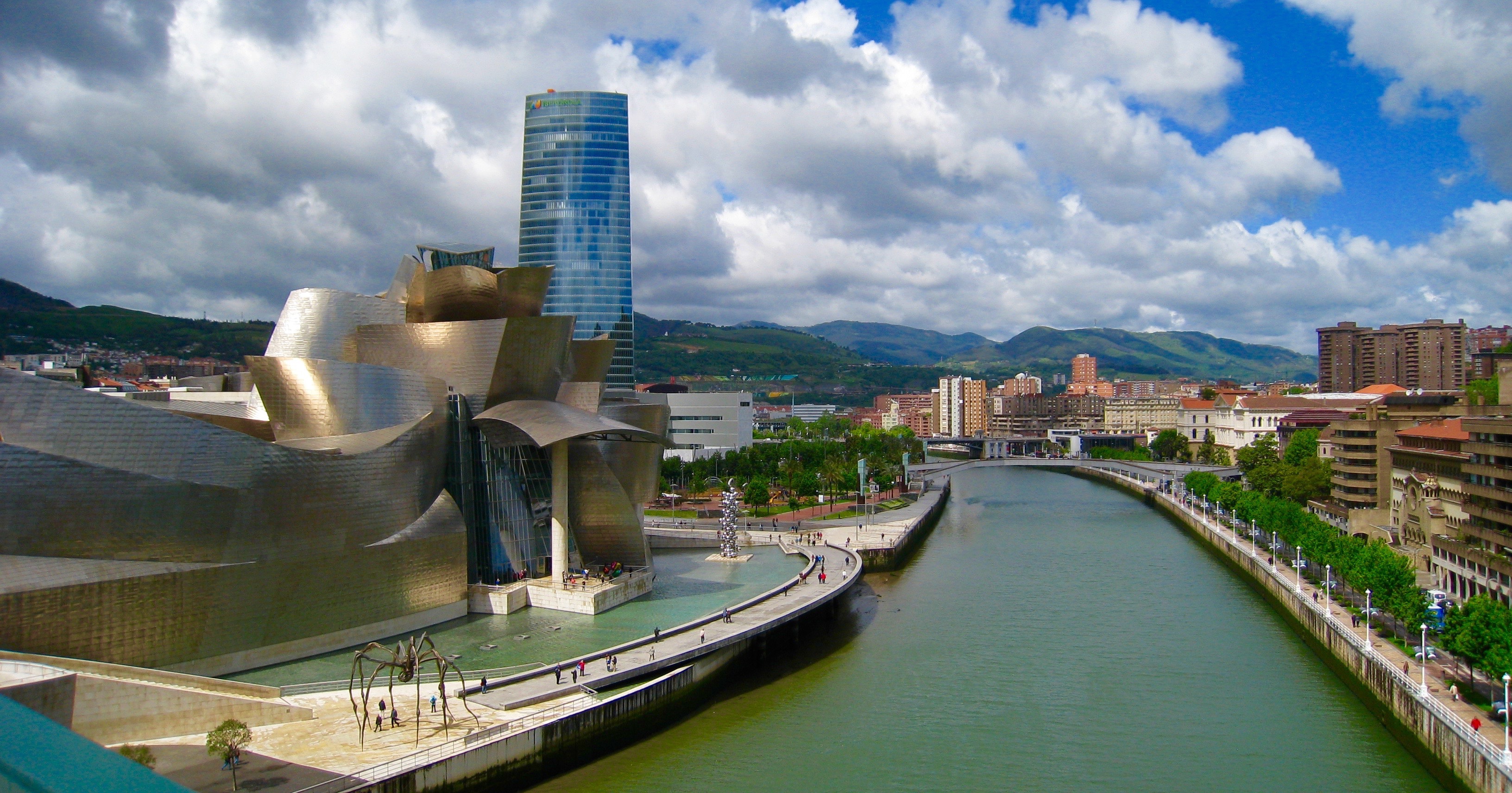
Another cloudy morning greeted us as we went downstairs for breakfast at the Albatros. We wanted to eat, then get a head start on the drive to Bilbao to visit the Guggenheim Museum, which I had wanted to visit since I’d seen Dancing House, also known as the Fred and Ginger house, in Prague, Czech Republic. I wasn’t as interested in the exhibits as much as the architecture of the building itself. I hoped the weather would hold so I could take some decent pictures. We filed into the dining room along with the French tour group, also up early but for an outing into the Spanish countryside. A pleasant and exuberant group, they asked if we would join them for breakfast. We politely declined and pointed out that their tables were reserved for their gathering only.
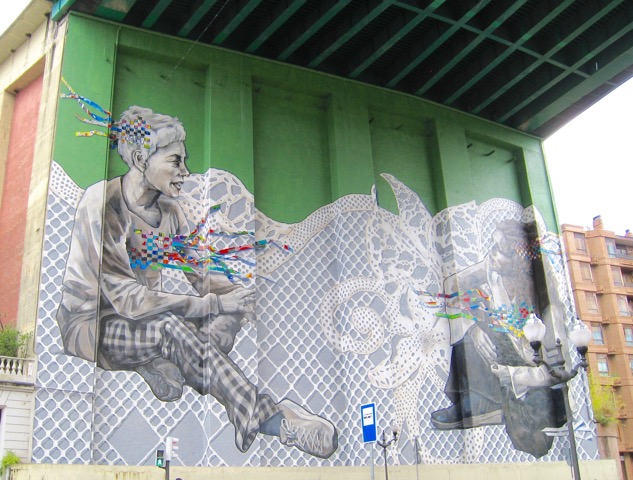
Mural Under Puente de la Salve
Rain pelted us during the hour-and-a-half drive from Suances to Bilbao, but despite the inclement weather we enjoyed the trip, especially when the road hugged the coastline along the Bay of Biscay. The rain and the terrain reminded me of the Florence, Oregon coastline. During my college days at the University of Oregon, I used to spend hours strolling the uninterrupted miles of beaches that stretched along the dazzling Pacific Ocean.
I knew from research that a thriving cultural sector is an essential part of any great city, just as expanses of greenbelts, which limit sprawl, are important to the health of urban dwellers and help them feel more connected to nature. But for me, the star-quality draw in Bilbao had nothing to do with green spaces. My sights were set on finally seeing Frank Gehry’s shimmering titanium, limestone, and glass attraction—the Guggenheim.
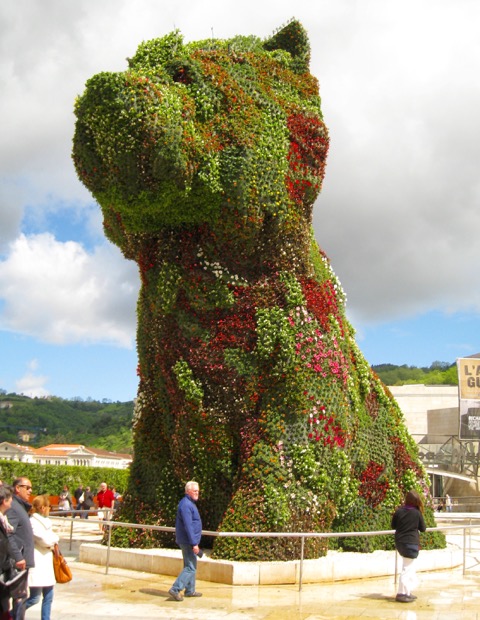
Puppy, by Jeff Koons
Prior to my visit to Bilbao, I had read an article about the “Bilbao Effect,” or “the Guggenheim Effect,” as the locals refer to it. By 1980, Bilbao, the fourth largest city in Spain, was decimated by the collapse of its steel and shipbuilding industries, its factories shuttered and its port in disrepair. After Spain joined the EU, the Basque authorities embarked on an ambitious revitalization program. They hired expensive architects to design a new airport, a metro system, and a footbridge, Zubizuri, designed by the neofuturistic architect Santiago Calatrava Valls. But the city’s biggest achievement was convincing Solomon R. Guggenheim to build a branch of the legendary Guggenheim Museum in Bilbao. For the project, they hired Frank Gehry. Critics referred to Gehry’s design as “mercurial brilliance.” The museum is the centerpiece of the Bilbao Art District.
Five years after construction, Bilbao estimated that the museum’s impact on the economy at around $168 million, more than the cost of construction of the building, which came in on budget at $89 million. In 2012, more than one million people visited the world-class museum, half of them from abroad. Bilbao has become the model for attracting investment, brands, tourism, and cultural energy through a historic cultural institution, which has transformed a struggling post-industrial city into a worldwide cultural power.
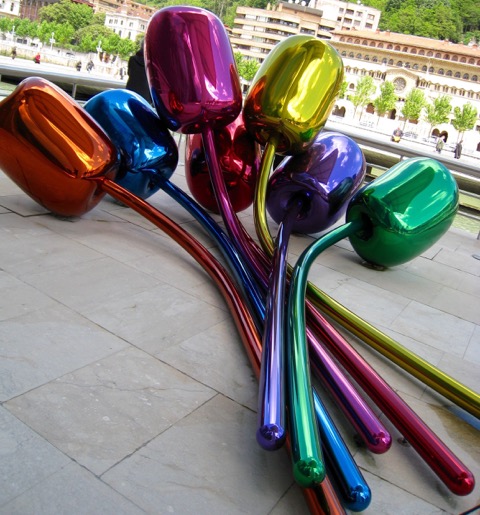
Tulips, by Jeff Koons
As we exited the motorway and threaded our way through Bilbao’s traffic-congested streets, the skies began to clear. We found a parking spot close to the Guggenheim and hopped out. Since it was still too overcast for picture taking, we decided to tour the museum first and snap photos later. I was in awe from the moment I laid eyes on Gehry’s building as we approached it from the massive steel Puente de la Salve, which crosses over the Nervión River.
At first, I had difficulty keeping my mind on the exhibits, eager for the sun to appear so I could shoot the exterior of the museum, but the significance of the exhibition, L’art en guerre, France 1938–1947: From Picasso to Dubuffet, soon grabbed and held my attention as I toured it. The exhibit had just closed in Paris and opened at the Guggenheim. We spent two somber hours working our way through the war and persecution exhibits, a solemn reminder of the horrors of the war and the genocide carried out because of hatred and fear of certain peoples and religions.
Jed Perl’s article in the New Republic is an accurate critique of the exhibition. Following is an excerpt from his article; a link to it appears at the end of this blog post.
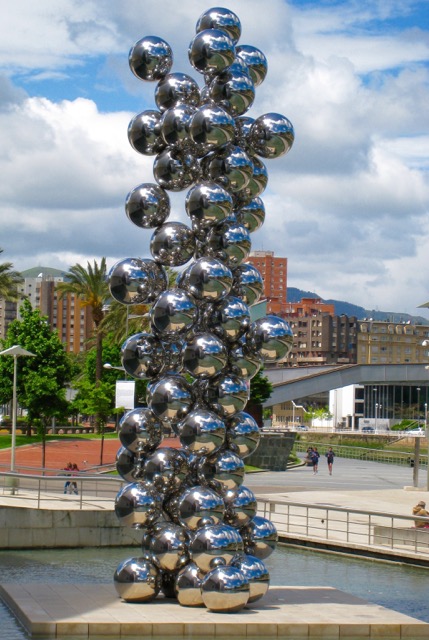
Reflectorama, by Anish Kapoor
The German occupation of Paris precipitated an extraordinary confrontation between the city where modern art was born and the regime that was determined to shatter modernity. The juxtapositions in this exhibition are harrowing. We are asked to take in both the luxuriantly sensuous visions of Henri Matisse and Pierre Bonnard, living in relative safety in Vichy France, and the stark, hardscrabble images done in detention camps by Charlotte Salomon, Otto Freundlich, and Felix Nussbaum, who would soon perish in the German death machine. If it is a story in which the moral giants are outnumbered by the moral pygmies, it is also a story that raises the gravest questions about the morality of art and the artist’s obligation to society.
Between 1939 and 1942, Camp des Milles, housed in a former brick factory, was an internment camp for political dissidents, artists, and intellectuals. After the summer of 1942, and the Nazi plan for the “final solution,” it became the holding site for almost ten thousand Jews awaiting deportation for extermination at Auschwitz. Having been stripped of their freedom and dignity, the detainees quickly organized themselves in order to survive the miserable living conditions. The painters, sculptors, writers, actors, and musicians interned at Camp des Milles had to be endlessly inventive in devising ways to ward off boredom and lift their spirits. Aside from writing and live theatrical and musical shows, over three hundred paintings and drawings are thought to have originated there. Among the “undesirables” held at the camp were Nobel Prize-winning physician Otto Fritz Meyerhof, Max Ernst, Golo Mann, Robert Liebknecht, and German author Lion Feuchtwanger, who escaped to the United States and described his experiences in the camp in his 1941 memoir, The Devil In France – My Encounter With Him In The Summer Of 1940.
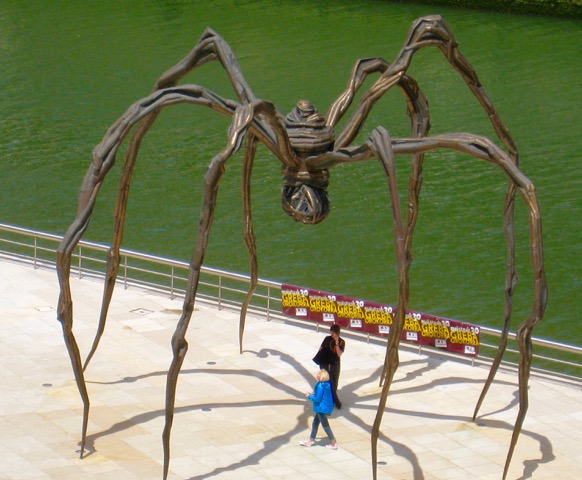
Maman, by Louise Bourgeois
Still discussing the war exhibit, Dave and I gravitated toward the Guggenheim café for a sweet and an espresso. Afterwards, we wandered the museum shop, made a few purchases, and returned to the soaring atrium with its pine, glass, and steel curves uncurling high above us. Lured outside by artist Jeff Koons’s work Tulips from his Celebration series, I snapped off several shots of his bouquet of mirror-polished stainless steel balloon flowers. I wished I had an arrangement of such beauty for my own yard. Also impressive is Louise Bourgeois’s tribute to her mother, the mammoth Maman, a nine-meter-tall bronze spider that suggests both protector and predator and embodies both strength and fragility. From the spider, I gravitated back to the tulips and on to a sculpture of cascading balls, Reflectorama, designed by the artist Anish Kapoor. And definitely original are Fire Fountain by deceased French artist Yves Klein, best seen at night as the photo insert shows, and Fujiko Nakaya’s Fog Bridge, in which steam floats out from under the Salve Bridge every hour. We circled back to the front of the museum and took several pictures of Jeff Koons’s giant, canine-topiary Puppy, one of the first works acquired by the curators. You can’t miss the forty-foot tall, flower-covered West Highland white terrier that isn’t white as you approach the Guggenheim from the Puente de la Salve. Under the bridge is a stunning mural (see photo). Everywhere you look in the Bilbao Art District, you are greeted with visual beauty.
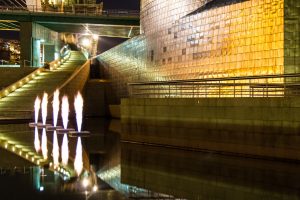
A short walk from the Guggenheim is Calatrava’s Zubizuri, Basque for “white bridge.” The design consists of a curved walkway, which is supported by steel suspension cables from an overhead arch; the deck consists of translucent glass bricks. Access ramps and stairways are located on both banks. I could easily have spent hours taking more photographs, but bad weather started to close in. Thankful for the photos snapped, we walked back across the Salve Bridge to our rental car. We tossed our drizzle-soaked Windbreakers into the backseat and motored out of Bilbao, bound for Suances.
That night, we ate at El Fanal. The establishment is owned by an Australian who is married to a Spaniard. He tends the restaurant, and she cooks. When we entered we were immediately greeted by the owner, who was friendly and outgoing. We sat at the bar and sipped a glass of wine while he talked about Australia, what we must see if we visited, and what had brought him to Suances. He showed us to our table and for starters recommended the grilled octopus. Perfection. The special of the day was a whole grilled turbot with smoky, spiced potatoes. Excellent. We also gave the nod to his wine suggestion, a Don Olegario Albariño 2012 that paired well with our seafood. For dessert, a homemade flan, something I will never turn down. Our flan arrived along with two glasses of a Spanish sherry “on the house,” a pleasant way to end a great meal in a relaxing atmosphere. Again, we had eaten too early for most Spanish diners and were alone in El Fanal until we finished our sherry. On our way out, we noticed most of the restaurant’s seats had filled.
“When the Surrealists Met the Nazis: Picasso, Paris, and modern art in Vichy France” by Jed Perl. The article can be read in its entirety.


0 Comments